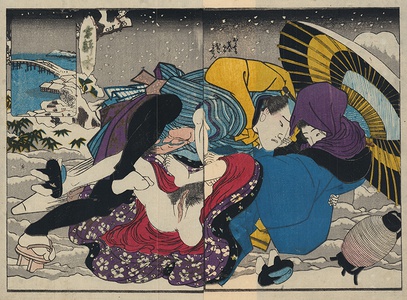| Method | Woodblock (nishiki-e) |
| Artist | attributed to Keisai Eisen (1790-1848) |
| Published | c. 1838-40 |
| Dimensions | Two Hanshibon sheets [each sheet ~222 x 155 mm] |
| Notes |
Series: Shunshoku hana no shizuku: Erotic Drops of Flower Petals The fourth double page image from Volume III of Eisen's Shunshoku hana no shizuku: Erotic Drops of Flower Petals, depicting an amorous couple toppling over in the snow. The woman is dressed in a heavy winter over kimono, a zukin (hood), and tall geta (sandals). Holding an open parasol, the woman's left sandal has come off and her lantern topples over next to her, the open parasol symbolic of the vulnerability of her exposed vagina. The man above has his left arm around the back of the woman as he holds her left leg up with is right hand. The inset koma-e (inset picture) is reminiscent of a Hiroshige landscape and includes the inscription, "all covered in snow" a double-entendre regarding the unfolding scene. A deluxe printing in rich colour with karazuri (blind stamping), tsuyazumi (lacquer printing), and mica dust. This print has been attributed to Eisen based on stylistic grounds by Jack Hillier, at the Pulverer Collection, specifically the floral cartouches and facial expressions of the figures. One of the pages in the series is signed "Gonomon Shunjono" of Shunjoshin, but no artist has been linked to this name. Shunga is the term used for the body of erotic imagery produced in Japan from 1600 to 1900. The term shunga means spring pictures, a euphemism for sex, and is one of several names for erotic material produced in Japan. Shunga took different formats: painted hand scrolls, painted books, printed books and albums, and sets of prints which were sometimes sold in wrappers. As prints they are one of the genres of ukiyo-e, or Floating World prints, which also include fukeiga (landscape prints), and bijin-ga (prints of beautiful women). Most of the major ukiyo-e artists produced shunga material at some point during their careers, including Utamaro (who produced more erotic books than non-erotic books), Hokusai, and Hiroshige. Produced at the same time as the introduction of full colour woodblock printing, shunga prints and books were made using the most lavish and complicated printing techniques, including gauffrage, metallic inks, mica, complicated printed patterns, and multicolour printing using a high number of different colours. Although prolific in its number and variety, shunga should be seen as more representative of the ideals of the ukiyo, with its emphasis on mutual pleasure, rather than as an accurate representation of Japanese attitudes and practices of sexuality. Shunga present an invitation to pleasure through the bliss of lovemaking and though largely heteronormative, they portray the full gamut of couplings, married or otherwise, often surrounded by lavish settings and objects of pleasure. Keisai Eisen (1790-1848) was a ukiyo-e artist born in Hoshigaoka in Edo Japan. The son of the samurai, poet, and calligrapher Ikeda Masahei Shigeharu, Eisen studied painting in the Kanō style under Kanō Hakkeisai from whom he got the name Keisai. He then went on to train as a kabuki playwright. After the death of his father, he lodged with the family of Kikugawa Eizan. It was then that Eisen became interested in ukiyo-e and studied under Eiji, Eizan's father. It was also at this time that he became interested in the work of Hokusai who heavily influenced his style. Eisen specialised in bijin-ga (pictures of beautiful women), including his o-kubi-e (large head pictures) and full length portraits, also made landscapes and pictures of famous places contributing 24 designs to Kisokaidō rokujūkyū-tsugi: Sixty-nine Stations of the Kisokaidō Road, c. late 1830s) designed with Hiroshige. He designed many erotic prints and book illustration as well as compiling medical texts and sex manuals into the four volume (Keichu kibun) Makura bunko: Heard and Recorded in the Bedroom: Pillow Library. In addition to prints, painting, and book illustrations Eisen also wrote novels, plays, history books, legends and biographies notably the second edition of Ukiyo-e Ruiko (History of Prints of the Floating World) which contains the most comprehensive collection of biographies of ukiyo-e artists including himself in which he describes himself as a heavy drinker and claimed to have owned a brothel in Nazu in the 1830s. Ex. Col: Peter Darach Reference: Pulverer Collection, FSC-GR-780.5.1-4., Ulhenbeck, Chris and Margarita Winkel, Japanese Erotic Fantasies, Hotei Publishing, 2005, p. 166. Condition: Small pinhole in sky. |
| Framing | framed |
| Price | £850.00 |
| Stock ID | 53146 |

